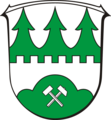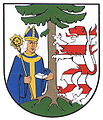Fir (heraldry)
In heraldry, the fir is a common figure with different symbolism. One also speaks of spruce , the two trees are generally not differentiated heraldically.
Representation and blazon
It is shown as an evergreen, predominantly strongly stylized tree in the coat of arms and stands for consistency and loyalty. Many wooded communities usually have a fir tree in their coat of arms . If several trees are shown, the heraldist limits himself to three.
The trunk can be of a different color. There are also coats of arms with a natural fir tree.
Also, it is possible to represent the roots, then it is as rooted or with roots to describe . It is usually still on the bottom, a torn fir tree is like this or is floating .

There is also the representation with cones ( tapped fir ). It turns out that the fir is the heraldic basic form, because the pins are in their normal form - as in nature - standing, hanging cones are either overthrown emblazoned: That would be the natural fruit form of spruce, so is this - contrary to the Type of growth - heraldically described as spruce with fallen cones . The cones are usually natural color (brown).
variants
Only the fir branch is widespread .
Occasionally, only the fruit cone (pine cone) is used in different numbers and shapes (example Sarrant ). It is mainly in silver or gold tinged . The point of the cone points upwards (which would be a real fir tree) if it is not with a branch in the shield (which would represent a spruce). The tenons can be three-pass or 2: 1.
With the concept fir these are fir Cross (all cross arms have a stylized pine branch), and the fir-section connected.
Usage and examples
Fir is particularly common in Finnish heraldry .
The fir tree also appears as a talking coat of arms , for example in the arms of the municipality of Thann (Alsace) and Tanne (Harz) .
stylized fir cut in the coat of arms of Heinersdorf on the table spruce
green-silver fir cut in the coat of arms of Nentershausen (Hesse) (bad cut, as the tips are rounded in an overturned shape)
stylized fir cut in the coat of arms of Varpaisjärvi , Finland
Rooted stylized fir tree with cones in the coat of arms of Kuusankoski , Finland
Fir cross in the coat of arms of Hunding (Lower Bavaria)
Coat of arms of Tannhausen , Baden-Wuerttemberg
Three fir trees with roots in Frankenhardt , Baden-Württemberg
Ceiling Pfronn is content with a pine branch, which is intended to emphasize the proximity to the Black Forest
Three fir trees each on a hill in the coat of arms of Tannheim , Baden-Württemberg
Fir on Dreiberg in the coat of arms of Densbueren , Switzerland
Coat of arms of Auma , Thuringia
Coat of arms of Tambach-Dietharz , Thuringia
Coat of arms of Bad Tennstedt , Thuringia
Coat of arms of Tanne (Harz) , Saxony-Anhalt
With squirrels : Coat of arms of Titisee-Neustadt , Baden-Württemberg
Individual evidence
- ^ Walter Leonhard : The great book of heraldic art. Development, elements, motifs, design. 2nd, revised and expanded edition. Georg DW Callwey, Munich 1978, ISBN 3-7667-0345-5 .
- ↑ Gert Oswald : Lexicon of Heraldry. VEB Bibliographisches Institut, Leipzig 1984.














